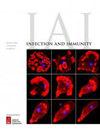粘附性和侵袭性大肠埃希菌的 CpxRA 双组分系统有助于上皮细胞侵袭和早期肠道健康,这种侵袭和健康是由 1 型缘毛表达介导的生物多样性不良小鼠模型造成的
IF 2.9
3区 医学
Q3 IMMUNOLOGY
引用次数: 0
摘要
克罗恩病(CD)是一种炎症性肠病,表现为胃肠道的慢性炎症性疾病(1, 2)。尽管克罗恩病的详细病因尚不清楚,但它的发病和发展似乎与多种因素有关,包括遗传、免疫和感染因素(3-5)。值得注意的是,伴有胃肠道炎症的肠道菌群失调是最常见的表现形式(6,7)。鉴于肠道菌群失调的定义是细菌多样性减少和微生物群组成失衡,人们推测某些细菌(称为病原菌,通常共生存在,但在特定条件下能引发疾病)与 CD 有关。迄今为止,一些细菌物种已被确定为可疑细菌(6-14)。在这些细菌中,一种病原菌--粘附和侵袭性大肠埃希菌(AIEC)在 CD 患者中非常普遍,已被广泛认为与 CD 有关(12, 15-18)。粘附和侵袭性大肠杆菌强烈粘附和侵袭肠上皮细胞,穿透上皮屏障,在巨噬细胞内存活,移动到深层组织,诱发炎症反应,并分泌促炎细胞因子(19)。本文章由计算机程序翻译,如有差异,请以英文原文为准。
The CpxRA two-component system of adherent and invasive Escherichia coli contributes to epithelial cell invasion and early-stage intestinal fitness in a dysbiotic mouse model mediated by type 1 fimbriae expression
Crohn’s disease (CD) is an inflammatory bowel disease that is represented as a chronic
inflammatory disorder of the gastrointestinal tract (1, 2). Although the detailed etiology of CD is still unclear, several factors appear to
be involved in the onset and progression of CD, including genetic, immunological,
and infectious factors (3–5). Notably, gut dysbiosis accompanied by gastrointestinal inflammation is the most
common manifestation (6, 7). Given that gut dysbiosis is defined by decreased bacterial diversity and an imbalanced
microbiota composition, it is speculated that certain bacteria, known as pathobionts,
typically existing in symbiosis but capable of triggering disease under specific conditions,
are involved in CD. To date, some bacterial species have been identified as suspicious
(6–14). Among such bacteria, a pathobiont, adherent and invasive Escherichia coli (AIEC), is significantly prevalent in CD patients and has been widely accepted to
be linked to CD (12, 15–18). AIEC strongly adheres to and invades intestinal epithelial cells, penetrates the
epithelial barrier, survives within macrophages, moves to deep tissues, and induces
inflammatory responses, along with secreting proinflammatory cytokines (19).
求助全文
通过发布文献求助,成功后即可免费获取论文全文。
去求助
来源期刊

Infection and Immunity
医学-传染病学
CiteScore
6.00
自引率
6.50%
发文量
268
审稿时长
3 months
期刊介绍:
Infection and Immunity (IAI) provides new insights into the interactions between bacterial, fungal and parasitic pathogens and their hosts. Specific areas of interest include mechanisms of molecular pathogenesis, virulence factors, cellular microbiology, experimental models of infection, host resistance or susceptibility, and the generation of innate and adaptive immune responses. IAI also welcomes studies of the microbiome relating to host-pathogen interactions.
 求助内容:
求助内容: 应助结果提醒方式:
应助结果提醒方式:


